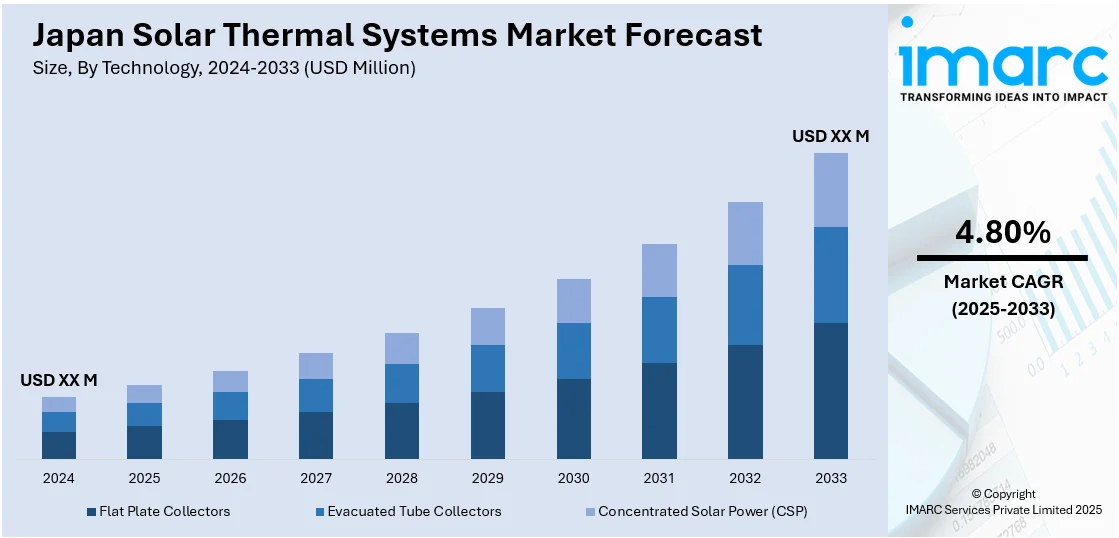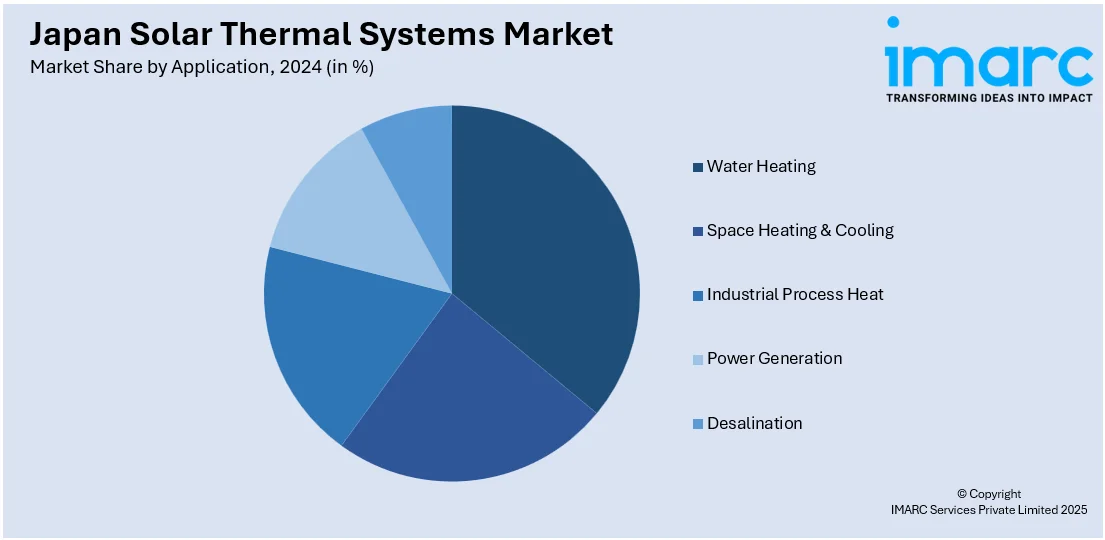
Japan Solar Thermal Systems Market Size, Share, Trends and Forecast by Technology, Application, End User, and Region, 2025-2033
Japan Solar Thermal Systems Market Overview:
The Japan solar thermal systems market size is projected to exhibit a growth rate (CAGR) of 4.80% during 2025-2033. The market is driven by residential demand for clean, self-sufficient heating. Also, industrial use for process heat and decarbonization goals is accelerating commercial integration. Additionally, urban regulations and energy codes are promoting technology adoption. Government subsidies, building performance mandates, disaster resilience priorities, pilot programs, hybrid system compatibility, and green certification requirements are some of the factors positively impacting the Japan solar thermal systems market share.
|
Report Attribute
|
Key Statistics
|
|---|---|
|
Base Year
|
2024 |
|
Forecast Years
|
2025-2033
|
|
Historical Years
|
2019-2024
|
| Market Growth Rate 2025-2033 | 4.80% |
Japan Solar Thermal Systems Market Trends:
Policy-Driven Urban Adoption and Building Code Alignment
Urban areas in Japan are seeing increased adoption of solar thermal systems driven by municipal regulations, green building certifications, and long-term decarbonization roadmaps. City-level initiatives in Tokyo, Yokohama, and Kyoto now promote the use of renewable thermal technologies through incentive programs and planning frameworks. These policies target both new construction and retrofits in multifamily housing, schools, and public buildings. The Tokyo Metropolitan Government, for example, offers support to building owners who integrate solar thermal into redevelopment projects or energy upgrades. Building owners are increasingly including these systems to meet CASBEE (Comprehensive Assessment System for Built Environment Efficiency) standards, which influence property values and eligibility for public contracts. National energy policies also reinforce this trend. The Ministry of Land, Infrastructure, Transport and Tourism has announced revisions to the Building Energy Efficiency Act that raise performance standards across all building categories. Developers and property owners are adopting solar thermal systems as a practical solution for compliance, particularly when paired with insulation upgrades and smart control systems. On 20 September 2024, IHI Corporation announced the successful demonstration of its Renewable Energy Thermal Utilization System in Soma City, Fukushima, which converts surplus solar-generated direct current (DC) into carbon-free steam using modified thermal-storage electric boilers. The system, featuring a 300 kW solar plant and seven boilers capable of absorbing up to 189 kW of surplus DC, recorded peak usage of 250 kW and helped prevent power loss from excess solar generation. Supported by a Fukushima Prefecture subsidy, the project aims to commercialize this Power-to-Heat (P2H) approach. These regulatory mechanisms, combined with local government incentives and evolving market expectations, are transforming urban adoption patterns and establishing a solid base for continued system deployment in cities.

Industrial Applications and Demand for Process Heat Decarbonization
Japan’s industrial sector, which includes chemicals, food processing, metal finishing, and textiles, accounts for a significant portion of national energy consumption. Many of these industries rely on medium-temperature heat for process operations, an area where solar thermal technology is now being evaluated as a substitute for conventional fuel-based systems. Companies seeking to cut emissions and manage long-term energy costs are exploring integration options, particularly in facilities with existing renewable energy experience. Pilot projects funded by NEDO (New Energy and Industrial Technology Development Organization) are testing scalable thermal systems for industrial applications. These trials aim to verify cost-effectiveness and reliability under Japanese climate conditions. Positive results have led to follow-up implementations in regional clusters, including manufacturing zones in Kansai and Chūbu. On 16 October 2024, Vena Energy commenced commercial operations of the 53 MW Kasama Solar Project in Ibaraki Prefecture, Japan, with the capacity to power over 14,000 households annually. The project is expected to offset approximately 38,000 tonnes of greenhouse gas emissions and save up to 54 million litres of water each year compared to conventional thermal energy production. The initiative aligns with Kasama City's “Zero Carbon City” goals and incorporates mandatory community agreements and environmental impact disclosures. Industrial users are also drawn to solar thermal for its minimal maintenance requirements and its compatibility with hybrid heating configurations. When integrated with conventional boilers, it can lower peak fuel consumption without requiring full system replacement. This approach allows businesses to meet emissions targets under the government’s Green Growth Strategy without disrupting operations. As more companies prioritize low-carbon operations, industrial use of thermal systems is expected to expand steadily.
Japan Solar Thermal Systems Market Segmentation:
IMARC Group provides an analysis of the key trends in each segment of the market, along with forecasts at the country and regional levels for 2025-2033. Our report has categorized the market based on technology, application, and end user.
Technology Insights:
- Flat Plate Collectors
- Evacuated Tube Collectors
- Concentrated Solar Power (CSP)
- Parabolic Trough
- Solar Tower
- Fresnel Reflectors
- Dish Stirling
The report has provided a detailed breakup and analysis of the market based on the technology. This includes flat plate collectors, evacuated tube collectors, and concentrated solar power (CSP) (parabolic trough, solar tower, Fresnel reflectors, and dish stirling).
Application Insights:

- Water Heating
- Space Heating & Cooling
- Industrial Process Heat
- Power Generation
- Desalination
The report has provided a detailed breakup and analysis of the market based on the application. This includes water heating, space heating & cooling, industrial process heat, power generation, and desalination.
End User Insights:
- Residential
- Commercial
- Industrial
- Agricultural
The report has provided a detailed breakup and analysis of the market based on the end user. This includes residential, commercial, industrial, and agricultural.
Regional Insights:
- Kanto Region
- Kansai/Kinki Region
- Central/Chubu Region
- Kyushu-Okinawa Region
- Tohoku Region
- Chugoku Region
- Hokkaido Region
- Shikoku Region
The report has provided a comprehensive analysis of all major regional markets, including Kanto Region, Kansai/Kinki Region, Central/Chubu Region, Kyushu-Okinawa Region, Tohoku Region, Chugoku Region, Hokkaido Region, and Shikoku Region.
Competitive Landscape:
The market research report has also provided a comprehensive analysis of the competitive landscape. Competitive analysis such as market structure, key player positioning, top winning strategies, competitive dashboard, and company evaluation quadrant has been covered in the report. Also, detailed profiles of all major companies have been provided.
Japan Solar Thermal Systems Market News:
- On 25 November 2024, Laketricity Japan (Ciel & Terre International Group) announced the completion and commissioning of the Benten Numa floating solar power plant in Saitama Prefecture, which began operations in July. The 1,490 kWp plant, comprising 2,240 Canadian Solar panels rated at 665 W each, is expected to generate 1,747 MWh annually, enough to power approximately 338 households and offset 745 tonnes of CO₂ emissions in its first year.
Japan Solar Thermal Systems Market Report Coverage:
| Report Features | Details |
|---|---|
| Base Year of the Analysis | 2024 |
| Historical Period | 2019-2024 |
| Forecast Period | 2025-2033 |
| Units | Million USD |
| Scope of the Report | Exploration of Historical Trends and Market Outlook, Industry Catalysts and Challenges, Segment-Wise Historical and Future Market Assessment:
|
| Technologies Covered |
|
| Applications Covered | Water Heating, Space Heating & Cooling, Industrial Process Heat, Power Generation, Desalination |
| End Users Covered | Residential, Commercial, Industrial, Agricultural |
| Regions Covered | Kanto Region, Kansai/Kinki Region, Central/Chubu Region, Kyushu-Okinawa Region, Tohoku Region, Chugoku Region, Hokkaido Region, Shikoku Region |
| Customization Scope | 10% Free Customization |
| Post-Sale Analyst Support | 10-12 Weeks |
| Delivery Format | PDF and Excel through Email (We can also provide the editable version of the report in PPT/Word format on special request) |
Key Questions Answered in This Report:
- How has the Japan solar thermal systems market performed so far and how will it perform in the coming years?
- What is the breakup of the Japan solar thermal systems market on the basis of technology?
- What is the breakup of the Japan solar thermal systems market on the basis of application?
- What is the breakup of the Japan solar thermal systems market on the basis of end user?
- What is the breakup of the Japan solar thermal systems market on the basis of region?
- What are the various stages in the value chain of the Japan solar thermal systems market?
- What are the key driving factors and challenges in the Japan solar thermal systems market?
- What is the structure of the Japan solar thermal systems market and who are the key players?
- What is the degree of competition in the Japan solar thermal systems market?
Key Benefits for Stakeholders:
- IMARC’s industry report offers a comprehensive quantitative analysis of various market segments, historical and current market trends, market forecasts, and dynamics of the Japan solar thermal systems market from 2019-2033.
- The research report provides the latest information on the market drivers, challenges, and opportunities in the Japan solar thermal systems market.
- Porter's five forces analysis assist stakeholders in assessing the impact of new entrants, competitive rivalry, supplier power, buyer power, and the threat of substitution. It helps stakeholders to analyze the level of competition within the Japan solar thermal systems industry and its attractiveness.
- Competitive landscape allows stakeholders to understand their competitive environment and provides an insight into the current positions of key players in the market.
Need more help?
- Speak to our experienced analysts for insights on the current market scenarios.
- Include additional segments and countries to customize the report as per your requirement.
- Gain an unparalleled competitive advantage in your domain by understanding how to utilize the report and positively impacting your operations and revenue.
- For further assistance, please connect with our analysts.
 Request Customization
Request Customization
 Speak to an Analyst
Speak to an Analyst
 Request Brochure
Request Brochure
 Inquire Before Buying
Inquire Before Buying




.webp)




.webp)












